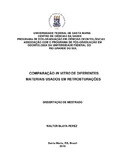| dc.creator | Perez, Walter Blaya | |
| dc.date.accessioned | 2010-05-25 | |
| dc.date.available | 2010-05-25 | |
| dc.date.issued | 2010-03-09 | |
| dc.identifier.citation | PEREZ, Walter Blaya. IN VITRO COMPARITIONS OF DIFERENT MARTERIALS USED IN RETROFILLINGS.. 2010. 66 f. Dissertação (Mestrado em Odontologia) - Universidade Federal de Santa Maria, Santa Maria, 2010. | por |
| dc.identifier.uri | http://repositorio.ufsm.br/handle/1/6062 | |
| dc.description.abstract | This research intended to evaluate three different materials, in vitro, for their capacity of sealing in root-end fillings. The sample was consisted by 30 single root teeth, having primarily realized root canal treatment and subsequently resected three mm from the apex, in an angle of 90° in relation to its long axis and in its apex, cavities with ultrasonic tips were prepared. Subsequently they were retro filled with different materials, randomized divided in three groups of ten teeth
each, according to the retrofilling product. Group 1: mineral trioxide aggregate (gray MTA Angelus®); Group 2: mineral trioxide aggregate (MTA Endo Sealer CPM®) and Group 3: a phosphate tricalcium cement. Its evaluation in relation to the apical sealing was obtained through the microleakage test with the Rodamine B solution 0.2%. Subsequently, the teeth were sectioned in their long axis by taking one of the parts and evaluating it in a dentistry microscope. Their images were captured and analyzed in the Image Tool 2.0 Software to determine the microleakage zones. The data was statistically analyzed using the STATA 9.0 program. First, an exploratory
analysis of the data was realized referring to the studied variables. The dependent variable considered in this study was the percentage of stained dentin, regardless of the type of sealant used in each resected root. The differences between the values of microleakage in each material were statistically evaluated by the Kruskal-Wallis test considering a minimum level of sufficiency up to 5%. Before the analysis, the Schapiro-Wilk test was applied to verify the normality of the data distribution. According to the test, a pattern of non-normal distribution of the dependent variable (p=0.002) could be observed. Higher values of infiltration could be observed in the group that used a tricalcium phosphate cement in relation to groups that used mineral trioxide aggregate (gray MTA- Angelus®) and mineral trioxide aggregate (MTA Endo Sealer CPM®) (p<0.001). There was no significant
difference in the values of infiltration between the MTA | eng |
| dc.format | application/pdf | por |
| dc.language | por | por |
| dc.publisher | Universidade Federal de Santa Maria | por |
| dc.rights | Acesso Aberto | por |
| dc.subject | Cirurgia paraendodôntica | por |
| dc.subject | Retrobturação | por |
| dc.subject | Microinfiltração apical | por |
| dc.subject | Retro-filling | eng |
| dc.subject | Apical microleakage | eng |
| dc.subject | Surgery | eng |
| dc.title | Comparação in vitro de diferentes materiais
usados em retrobturações | por |
| dc.title.alternative | In vitro comparitions of diferent marterials used in retrofillings. | eng |
| dc.type | Dissertação | por |
| dc.description.resumo | Esta pesquisa teve por alvo a avaliação de três diferentes materiais, in vitro, quanto à sua capacidade de selamento em retrobturações. A amostra foi constituída por 30 dentes
monorradiculares, tendo, primeiramente, realizado tratamento endodôntico e posteriormente apicetomizados a três mm do ápice, em um ângulo de 90° em relação ao seu longo eixo e, em seu ápice, confeccionadas cavidades com pontas ultrassônicas. Posteriormente foram retrobturados com materiais diferentes: divididos em três grupos aleatoriamente de dez dentes cada um, de acordo com o produto retrobturador. Grupo 1, agregado trióxido mineral (MTA
cinza - Angelus®), Grupo 2, agregado trióxido mineral (MTA - CPM Endo Sealer®) e Grupo 3, cimento de α fosfato tricálcio. Sua avaliação em relação ao vedamento apical foi obtida
através do teste de microinfiltração com a solução de Rodamina B 0,2%. Posteriormente os dentes foram seccionados em seu longo eixo, tomando-se uma das partes e, avaliando-se em microscópio Odontológico, suas imagens foram captadas e analisadas no Software Imagem
Tool 2.0, para determinar as zonas de microinfiltração. Os dados foram analisados estatisticamente, utilizando-se o programa STATA 9.0. Primeiramente se realizou a análise
exploratória dos dados referentes às variáveis estudadas. A variável dependente considerada neste estudo foi o percentual de dentina corada, independentemente do tipo de material selador utilizado na apicectomia. As diferenças entre os valores de microinfiltração em cada material foram avaliadas estatisticamente através do teste de Kruskal-Wallis, considerando um nível mínimo de suficiência de até 5%. Previamente às análises, foi aplicado o teste de Schapiro-Wilk para verificar a normalidade de distribuição dos dados. De acordo com o teste, observou-se um padrão de distribuição não-nomal das variáveis dependentes. Maiores valores
de infiltração puderam ser observados no grupo que utilizou o cimento de α fosfato tricálcio em relação aos grupos do agregado trióxido mineral (MTA cinza - Angelus®) e agregado
trióxido mineral (MTA - CPM Endo Sealer®) (p<0,001). Não houve diferença estatisticamente significativa nos valores de infiltração entre os MTA (p>0,05). | por |
| dc.contributor.advisor1 | Carvalho, Maria Gabriela Pereira de | |
| dc.contributor.advisor1Lattes | http://buscatextual.cnpq.br/buscatextual/visualizacv.do?id=K4727516A6 | por |
| dc.contributor.referee1 | Escobar, Carlos Alberto Bazaglia | |
| dc.contributor.referee1Lattes | http://buscatextual.cnpq.br/buscatextual/visualizacv.do?id=K4782041Y1 | por |
| dc.contributor.referee2 | Isolan, Tania Maria Pereira | |
| dc.contributor.referee2Lattes | http://buscatextual.cnpq.br/buscatextual/visualizacv.do?id=K4763428Y7 | por |
| dc.creator.Lattes | http://buscatextual.cnpq.br/buscatextual/visualizacv.do?id=K4737463J3 | por |
| dc.publisher.country | BR | por |
| dc.publisher.department | Odontologia | por |
| dc.publisher.initials | UFSM | por |
| dc.publisher.program | Programa de Pós-Graduação em Ciências Odontológicas | por |
| dc.subject.cnpq | CNPQ::CIENCIAS DA SAUDE::ODONTOLOGIA | por |


